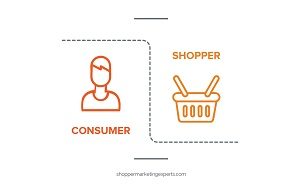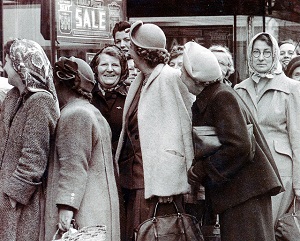 It seems this recent post on the definition of shopper marketing created a bit of a buzz. And not just on which definition was ‘right’. But also on the whole idea of shoppers vs consumers, whether they were different, and what was the difference. The debate clearly showed is that there is no common understanding of the difference between consumers and shoppers – with some still standing by the view that they are exactly the same. In our work, we’ve found that understanding shoppers vs consumers is of critical importance and massive value. Thanks to Tim Manners for stirring the pot and giving me the impetus to write this post.
It seems this recent post on the definition of shopper marketing created a bit of a buzz. And not just on which definition was ‘right’. But also on the whole idea of shoppers vs consumers, whether they were different, and what was the difference. The debate clearly showed is that there is no common understanding of the difference between consumers and shoppers – with some still standing by the view that they are exactly the same. In our work, we’ve found that understanding shoppers vs consumers is of critical importance and massive value. Thanks to Tim Manners for stirring the pot and giving me the impetus to write this post.
Shoppers vs Consumers
As a start, a simple definition. The consumer is the person who uses the product or service. They eat the food, drink the drink, watch the TV, sit on the chair. The shopper is the person who engages in activities connected with (but not limited to) buying that product (or service). Researching, comparing, seeking deals and actually buying – they are all broadly shopping activities. Yes there is a bit of a blurry line between some of these, and yes, there are times when perhaps the person is a little bit consumer and a little bit shopper: let’s pick that up in a moment.
The Shopper Is Not Always The Consumer
In every category we’ve studied, some of the people buying are not buying for themselves. Every category (and we’ve studied a lot). No exceptions. In many categories (toys for example) the number of shoppers who are not consumers is very high. In some markets, almost half of male personal care products are bought by women. In some markets, the majority of beer in the home is drunk by men, but shoppers are 50% female. Even in an intimate and highly personal category such as feminine hygiene, there are a small number of people buying for others (mothers and embarrassed husbands, typically). In every category the story is the same. Some shoppers are not consumers.
Why is this important? Check out this post for more details on the marketing implications of when the shopper isn’t the consumer.
Shoppers vs consumers – a very different context
Even when the consumer and the shopper are the same person, they are different because they are in a very different context. When looking at the same individual through two separate lenses (the shopper one and the consumer one) one sees very different things. One consumer might even be different types of shoppers in different stores. Think how you might be described as a shopper in a supermarket versus in a convenience store – same person, same consumer perhaps, but a very different shopper. Imagine me as a consumer of, let’s say, a soft drink, at home. That’s me as a consumer. But as a shopper I could be two quite different shoppers, for that one consumption occasion. I could grab a can of Coke on the way home from work, and take it home with me. Or I could be buying a full week’s groceries at a supermarket, and Coke is only part of that shopping mission. One consumer, two potential shoppers. In the context of a store, we are simply different.
Shoppers vs consumers. In each state, our purpose and needs are different. Our decisions as a shopper aren’t always about one brand or one purchase. We might be buying many things. My decision to not buy a certain brand of washing powder might be little to do with the washing powder category, and more to do with the rest of my shop (maybe I only have limited funds and need to buy some other stuff, or maybe I walked to the store and the other brand was too bulky). These decisions have little to do with ‘the brand/consumption moment’ at home – and everything to do with the specific context: this shopping trip. A decision about shopping in a store versus online might be because its ‘a day out’ – and have nothing to do with consumption at all!
Shoppers vs consumers: different brand relationships
Even when the consumer and the shopper are the same person, shoppers and consumers have fundamentally different relationships with brands. Consumers can have very intense brand relationships. For example, there are some brands I really love. Not many, but some are truly awesome. When do I love these brands? Where do I love them? I love them when I’m consuming. I love them at the point of consumption (or at the point of anticipation of consumption). I love my minty shower gel when it zings me in the shower in the morning. After that, I don’t give it a second thought for the rest of the day. At that precise moment, it is awesome. Ten minutes later I’ve “dumped” it for that Illy coffee which is hitting the spot at the breakfast table. Consumers are promiscuous, and their love is short-lived. My love lasts for a few precious moments of consumption, and then I’m off professing my love for the next brand. A consumer’s brand relationships may be intense, and may be long lasting, but the periods of intensity that you, my dear brand, are ‘in the zone’, are fleeting.
Shoppers vs consumers: shoppers have less brand love
And that love is rarely there when I’m shopping. Apple may be able to recreate powerful brand relationships in their stores, but they are the exception. Typically a shopper is in shopping mode, not loving mode…. And that makes the shopper a completely different target with a very different brand relationship.
Here at the shelf the brand I love is just another product, and it’s hard for marketers to conjure up that “consumer-love” that exists at the point of consumption. In the store brand relationships are diluted by all of the other stuff that is going on: the noise, the deals, and all the other elements of my shopping mission. In the shower, that shower gel was the main event, but here in the store it is only a small contributor: my budget, my time, the check-out queue, the other things I need to buy today – they are all vying for my attentions. At this point, as a shopper, I am so far removed from the intimacy of the consumption moment. Where I do buy a brand regularly, it is often out of habit, more than love – it’s easier that way, and no other brand is offering enough of a reason for me to switch.
Brands need to win with consumers and shoppers
The problem is, however, that it’s hard to draw the line between ‘consumer’ and ‘shopper’ (unless they are separate people!) – As a person I’m always part shopper, part consumer. My shopping decisions are informed by my experience of the brand as a consumer. We need to integrate our marketing to shoppers and to consumers. Not ignore the differences, but to recognize both. Integration is not homogenization. Shoppers and consumers are different. They make different decisions and think differently about brands. We want them to do different things. He challenge is to celebrate their differences, understand how we should market to both shoppers and consumers, and then integrate them. If you want to know more about how to do that, check out Shopper Marketing Experts – which will help you with all things shopper marketing!
Image courtesy of Shopper Marketing Experts






